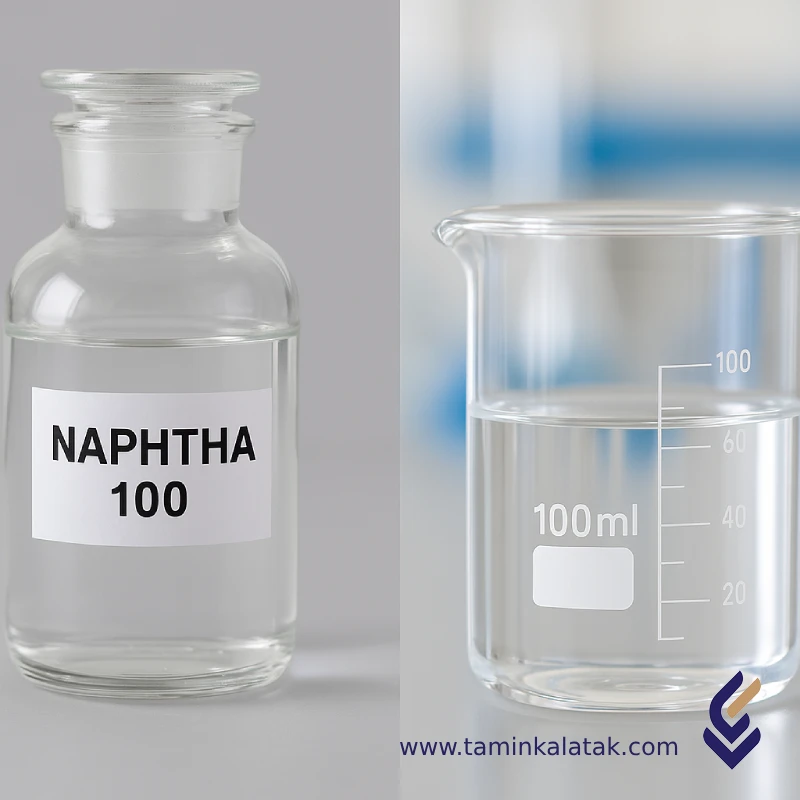Nafta 100
Naphtha 100 is a liquid mixture of aliphatic and aromatic hydrocarbons with short to medium carbon chains. It is obtained from the distillation of crude oil and is known as a highly volatile industrial solvent.
Naphtha 100 typically has a boiling range of 100–150°C and a density between 0.75 and 0.78 g/cm³.
CAS Number: 64742-48-9 (Hydrotreated Light Naphtha)
General Chemical Formula: C₅–C₁₀ (mixture of hydrocarbons)
Appearance: Colorless, transparent liquid
Odor: Mild petroleum-like odor
Properties of Naphtha 100
-
High Volatility: Due to its relatively low boiling point, it evaporates quickly.
-
Strong Solvency: Capable of dissolving various resins, oils, and fats.
-
Flammability: Highly flammable (Flammable Liquid, Category 2 – GHS) and must be handled with care.
-
Colorless and Clear: Its transparent appearance makes it useful in various applications.
Applications of Naphtha 100
Paints and Coatings Industry: Used as a solvent in the production of paints and varnishes.
Printing Industry: Used in the manufacture of printing inks and cleaning agents.
Adhesives and Resins Industry: Serves as a solvent and diluent for resins and adhesives.
Automotive Industry: Used in car care products such as waxes and cleaners.
Textile Industry: Applied in fabric cleaning and preparation processes.
Petrochemical Industry: Used as a feedstock for the production of chemicals and fuels.
Advantages of Naphtha 100
-
High Solvency Power: Excellent ability to dissolve a wide range of substances.
-
Fast Evaporation: Reduces drying time in various applications.
-
Availability: Readily available in the market at a reasonable cost.
-
Versatility: Can be used across multiple industries.
Disadvantages of Naphtha 100
-
High Flammability: Requires careful handling and storage.
-
Health Risks: Inhalation of vapors may cause dizziness, headaches, respiratory irritation, and, with prolonged exposure, may damage the nervous system and liver.
-
Environmental Impact: If spilled or improperly disposed of, it can harm the environment and surface waters.
-
Chemical Incompatibility: May react with strong oxidizing agents.
Safety and Storage of Naphtha 100
GHS Hazards:
-
H225: Highly flammable liquid and vapor.
-
H304: May be fatal if swallowed and enters airways.
-
H336: May cause drowsiness or dizziness.
-
H411: Toxic to aquatic life with long-lasting effects.
Safety Precautions
-
P210: Keep away from heat, sparks, and open flames.
-
P261: Avoid breathing vapors.
-
P280: Wear protective gloves and safety goggles.
-
P301+P310: IF SWALLOWED, immediately call a poison control center or doctor.
Storage Conditions:
Store in tightly closed containers in a cool, dry, and well-ventilated area.
Keep away from heat sources and direct sunlight.
Containers must be flame-resistant and compatible with hydrocarbons.
Applications
| Applications | , , , , |
|---|
Nafta 100
| Solubility in water | Melting point | Density (at 20°C) | Physical appearance | Vapor pressure | Grade | CAS number | Chemical formula | Products |
|---|---|---|---|---|---|---|---|---|
| Insoluble or very slightly soluble (less than 0.01 g/L) | Less than -30 °C (approximately) | 0.75 – 0.78 g/cm³ | Colorless, clear liquid with a mild petroleum odor. | About 4 – 10 mmHg | Industrial Grade | 64742-48-9 | C₅–C₁₀ (مخلوطی از هیدروکربنهای آلیفاتیک و آروماتیک) | (Naphtha 100) – Hydrotreated Light Naphtha |







